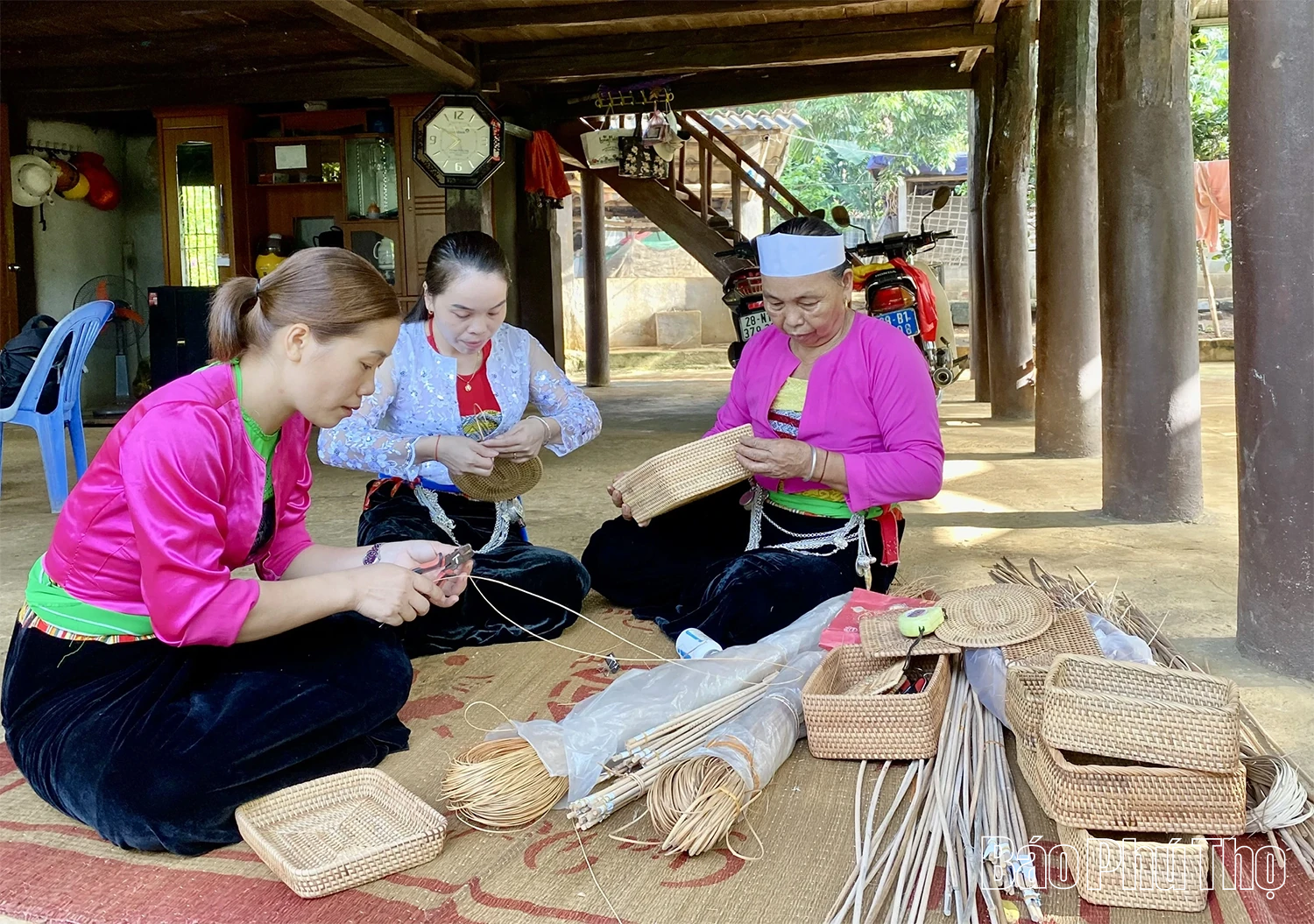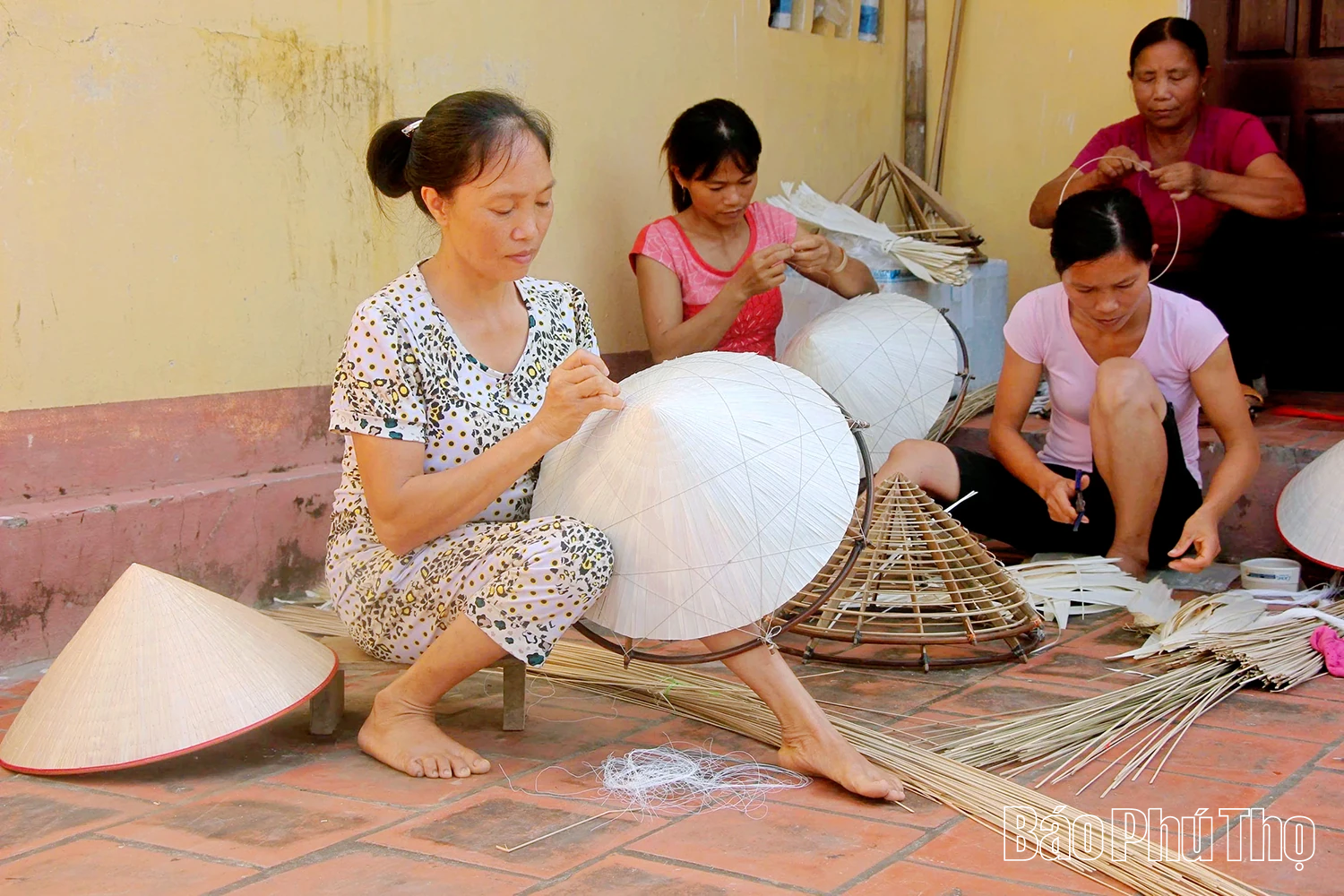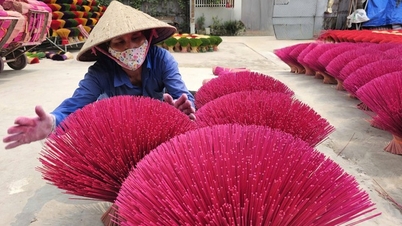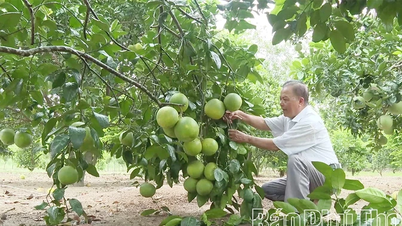Bamboo and rattan weaving village in Bui hamlet, Nhan Nghia commune - skillful hands preserve traditional identity through each rattan and bamboo strip.
Stories from craft villages
One early morning in Sai Nga conical hat village (Cam Khe), on the porch of tiled-roof houses, each pair of hands nimbly sews leaves and whittles bamboo. The sound of scissors cutting, the sound of needles carving the hat brims, combined with the smell of newly stripped bamboo, creates a familiar rhythm of the nearly 80-year-old craft village. The hat-making profession came to Sai Nga during the evacuation period, following the people of Chuong village ( Hanoi ) and took root on this land, supporting many generations. Now, about 500 households are still attached, making about 550,000 hats each year, bringing in tens of billions of VND. Sai Nga was recognized as a craft village in 2004, Sai Nga conical hats achieved 3-star OCOP in 2021 and upgraded to 4-star in 2024.
At the gateway to the Northwest, Mai Ha wine-making village (Mai Ha commune) of the Thai people has always been burning from generation to generation. The secret lies in the leaf yeast made from dozens of wild herbs such as wild galangal, ginger, guava, persimmon, grapefruit... Dried cassava is fermented with yeast, distilled in a hollowed wooden pot, producing a clear, warm, strong but smooth wine. From being used only in festivals, Mai Ha wine has now become an OCOP product, bottled, labeled, and widely consumed. Currently, there are 33 households maintaining the profession, with Ms. Vi Thi Ton's "Lau Sieu" facility alone reaching over 30,000 liters/year, with a revenue of about 1.5 billion VND.
From Sai Nga conical hats to Mai Ha wine yeast, each craft village has its own color but all contribute to creating the appearance of Phu Tho 's craft villages: vibrant, durable, preserving the cultural soul and providing livelihoods for tens of thousands of people. According to the Department of Rural Development, the whole province has more than 110 craft villages and hundreds of villages with active crafts, attracting over 30,000 households and dozens of cooperatives and enterprises, creating jobs for about 43,000 workers. Income ranges from 5 - 7 million VND/person/month in small craft villages, seasonal production, to tens of millions of VND in places with stable markets and export products.
However, the number of young craftsmen is decreasing. "The shift of labor to industrial zones, combined with the change in the habit of using conical hats, has made young people no longer interested in the profession," said Mr. Nguyen Huu Chi, Chairman of the People's Committee of Cam Khe commune. Many craft villages still face difficulties in capital, outdated equipment, fragmented production, dependence on traders, and lack of stable consumption channels. Rising raw material prices, epidemics, environmental pollution, etc., make it even more difficult to maintain the profession.
Open direction for craft villages
Maintaining the profession is difficult, developing the profession requires a long-term strategy. Comrade Nguyen Thanh Hiep - Deputy Head of the Department of Rural Development said: "If we only rely on traditional consumption habits, it will be difficult for the craft village to survive". The way to both maintain the spirit of the profession and stand firm in the market is to boldly apply technology, standardize production processes, and expand the market through tourism and e-commerce.
Sai Nga conical hat village (Cam Khe) - more than 80 years of keeping the profession, each needle and thread creates the unique charm of the conical hat of the homeland.
The province's goal is that by 2030, the rural industry group will strive to grow by 6-7% per year, the average income of workers will increase by more than 2.5 times compared to 2020, the rate of trained workers will reach 80% or more, of which at least 35% will have a diploma or vocational certificate. By 2045, rural industries will become a sustainable, smart, environmentally friendly economic pillar, associated with a green - clean - beautiful rural space and the preservation of traditional cultural values. To achieve these goals, three "spearheads" have been clearly identified: training and retaining the young generation, innovating technology and building a strong brand. In many places, the model of "home-based vocational classes" has been formed, helping young people to both learn systematically from artisans and earn income right in their hometown.
The industrial promotion capital has become a boost for craft villages to replace old machinery, increase productivity, and improve product quality. Products are now not only available at rural markets but also have traceability stamps, participate in OCOP, and are present at fairs, supermarkets, and e-commerce platforms. A promising direction is to combine craft villages with experiential tourism. Tourists can dye fabrics, make pottery, sew hats, and then bring home a homemade gift - a "unique" one that tells their own story. Where things do well, such as some weaving, blacksmithing, or woodworking villages, the number of visitors increases steadily every year, leading to the development of local accommodation and culinary services.
These steps, if persisted, will not only help craft villages in the province stand firm in the face of challenges, but also turn them into cultural and economic highlights of the midland region, where tradition and modernity blend together.
Time and the pace of life have changed, but in each craft village, the identity still exists in the sound of the forging hammer, the warmth of the charcoal stove, and the scent of raw materials. It is the heartbeat of a community that has been close for generations, and preserving it is not only the job of the craftsmen but also the responsibility of the government, businesses, and people.
The problem of preserving the profession and opening up the way has an answer: Innovate to bring products to the market with new competitiveness but still keep the old story and soul. So that each product when leaving the hands of the craftsman not only has material value but also is a part of the identity of the land of origin.
Nguyen Yen
Source: https://baophutho.vn/phu-tho-va-bai-toan-giu-nghe-mo-loi-di-moi-237937.htm





![[Photo] Prime Minister Pham Minh Chinh meets with representatives of outstanding teachers](https://vphoto.vietnam.vn/thumb/1200x675/vietnam/resource/IMAGE/2025/11/15/1763215934276_dsc-0578-jpg.webp)



![[Photo] General Secretary To Lam receives Vice President of Luxshare-ICT Group (China)](https://vphoto.vietnam.vn/thumb/1200x675/vietnam/resource/IMAGE/2025/11/15/1763211137119_a1-bnd-7809-8939-jpg.webp)






































































































Comment (0)